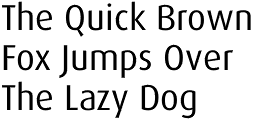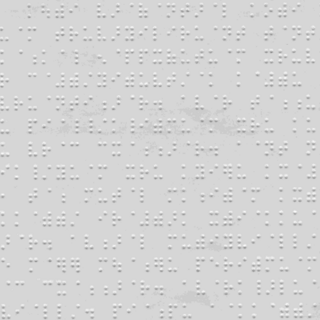Spanish Braille
Last updated| Spanish Braille ⠨⠃⠗⠁⠊⠇⠇⠑ ⠑⠎⠏⠁⠻⠕⠇ | |
|---|---|
| Script type | Alphabet |
Print basis | Spanish alphabet |
| Languages | Spanish, Galician |
| Related scripts | |
Parent systems | Braille
|
Child systems | Guarani Braille |
Sister systems | Portuguese Braille |
Spanish Braille is the braille alphabet of Spanish and Galician. It is very close to French Braille, with the addition of a letter for ñ, slight modification of the accented letters and some differences in punctuation. Further conventions have been unified by the Latin American Blind Union, but differences with Spain[ citation needed ] remain.
Contents
Alphabet
The French Braille letters for vowels with a grave accent, à è ù, are used in Spanish Braille for vowels with an acute accent, á é ú. In addition, French ⠻ï is reassigned to Spanish ñ. Thus, in numerical order, the letters are:
At one point, French ⠺w was apparently used for Spanish ü, reflecting its pronunciation, and French ⠹ô (a rotated v) for Spanish w, which is only found in foreign words. [1]
Digits
Digits are the first ten letters of the alphabet, and are marked by ⠼, as in English Braille.
Punctuation
Single punctuation:
| | | | | | | | | |
| , | . [2] | ' | ; | : | * | - | — | / |
(The same character is used for a full stop and for an apostrophe, as in Portuguese Braille. Spanish does not use the apostrophe in standard writing, and in Portuguese it is only present in a few fixed phrases.)
Paired punctuation:
| | | | | | | |
| ¿ ... ? | ¡ ... ! | (outer quotes) [3] | (inner quotes) [3] | ( ... ) | [ ... ] | { ... } |
Formatting
| | | |
| (digit) | (caps) | (start & stop emph.) |
'Emphasis' may be bold or italic in print.
See Portuguese Braille for a more complete account, much of which is likely to apply to Spanish Braille.
Other languages
The full Spanish Braille alphabet is used for Galician as well. The letter ⠻ for ñ is shared with Basque Braille (which has no additional letters) and with Guarani Braille (which does). It is not, however, used for the languages of the Philippines, which instead use an accent dot of English Braille with n, ⠈⠝, for ñ. (See basic braille.)
Punctuation for Galician and Basque Braille is the same as that of Spanish Braille.
Related Research Articles
A diacritic is a glyph added to a letter or to a basic glyph. The term derives from the Ancient Greek διακριτικός, from διακρίνω. The word diacritic is a noun, though it is sometimes used in an attributive sense, whereas diacritical is only an adjective. Some diacritics, such as the acute ( ◌́ ) and grave ( ◌̀ ), are often called accents. Diacritics may appear above or below a letter or in some other position such as within the letter or between two letters.
The acute accent, ◌́, is a diacritic used in many modern written languages with alphabets based on the Latin, Cyrillic, and Greek scripts. For the most commonly encountered uses of the accent in the Latin and Greek alphabets, precomposed characters are available.
The African reference alphabet is any of several proposed guidelines for the creation of Latin alphabets for African languages. The initial proposals were made at a 1978 UNESCO-organized conference held in Niamey, Niger, based on the results of several earlier conferences on the harmonization of the Latin alphabets of individual languages, with a substantial overhaul proposed in 1982. None have official standing. The 1978 conference recommended the use of single letters for speech sounds instead of two-letter or three-letter sequences, or of letters with diacritics.

The alphabet for Modern English is a Latin-script alphabet consisting of 26 letters, each having an upper- and lower-case form. The word alphabet is a compound of the first two letters of the Greek alphabet, alpha and beta. The alphabet originated around the 7th century to write Old English from Latin script. Since then, letters have been added or removed to give the current letters:
The Guarani alphabet (achegety) is used to write the Guarani language, spoken mostly in Paraguay and nearby countries. It consists of 33 letters.

Russian Braille is the braille alphabet of the Russian language. With suitable extensions, it is used for languages of neighboring countries that are written in Cyrillic in print, such as Ukrainian and Mongolian. It is based on the Latin transliteration of Cyrillic, with additional letters assigned idiosyncratically. In Russian, it is known as the Braille Script.

Bharati braille, or Bharatiya Braille, is a largely unified braille script for writing the languages of India. When India gained independence, eleven braille scripts were in use, in different parts of the country and for different languages. By 1951, a single national standard had been settled on, Bharati braille, which has since been adopted by Sri Lanka, Nepal, and Bangladesh. There are slight differences in the orthographies for Nepali in India and Nepal, and for Tamil in India and Sri Lanka. There are significant differences in Bengali Braille between India and Bangladesh, with several letters differing. Pakistan has not adopted Bharati braille, so the Urdu Braille of Pakistan is an entirely different alphabet than the Urdu Braille of India, with their commonalities largely due to their common inheritance from English or International Braille. Sinhala Braille largely conforms to other Bharati, but differs significantly toward the end of the alphabet, and is covered in its own article.
Greek Braille is the braille alphabet of the Greek language. It is based on international braille conventions, generally corresponding to Latin transliteration. In Greek, it is known as Κώδικας Μπράιγ Kôdikas Brég "Braille Code".

The Esperanto language has a dedicated braille alphabet. One Esperanto braille magazine, Esperanta Ligilo, has been published since 1904, and another, Aŭroro, since 1920.
The goal of braille uniformity is to unify the braille alphabets of the world as much as possible, so that literacy in one braille alphabet readily transfers to another. Unification was first achieved by a convention of the International Congress on Work for the Blind in 1878, where it was decided to replace the mutually incompatible national conventions of the time with the French values of the basic Latin alphabet, both for languages that use Latin-based alphabets and, through their Latin equivalents, for languages that use other scripts. However, the unification did not address letters beyond these 26, leaving French and German Braille partially incompatible and as braille spread to new languages with new needs, national conventions again became disparate. A second round of unification was undertaken under the auspices of UNESCO in 1951, setting the foundation for international braille usage today.
The braille alphabet used to write Hungarian is based on the international norm for the 27 basic letters of the Latin script. However, the letters for q and z have been replaced, to increase the symmetry of the accented letters of the Hungarian alphabet, which are largely innovative to Hungarian braille.

French Braille is the original braille alphabet, and the basis of all others. The alphabetic order of French has become the basis of the international braille convention, used by most braille alphabets around the world. However, only the 25 basic letters of the French alphabet plus w have become internationalized; the additional letters are largely restricted to French Braille and the alphabets of some neighboring European countries.
Luxembourgish Braille is the braille alphabet of the Luxembourgish language. It is very close to French Braille, but uses eight-dot cells, with the extra pair of dots at the bottom of each cell to indicate capitalization and accent marks. It is the only eight-dot alphabet listed in UNESCO (2013). Children start off with the older six-dot script, then switch to eight-dot cells when they start primary school and learn the numbers.
Scandinavian Braille is a braille alphabet used, with differences in orthography and punctuation, for the languages of the mainland Nordic countries: Danish, Norwegian, Swedish, and Finnish. In a generally reduced form it is used for Greenlandic.
Portuguese Braille is the braille alphabet of the Portuguese language, both in Portugal and in Brazil. It is very close to French Braille, with slight modification of the accented letters and some differences in punctuation.
IPA Braille is the modern standard Braille encoding of the International Phonetic Alphabet (IPA), as recognized by the International Council on English Braille.
Hawaiian Braille is the braille alphabet of the Hawaiian language. It is a subset of the basic braille alphabet,
Guarani Braille is the braille alphabet of the Paraguayan Guarani language. Letter assignments are those of Spanish Braille : that is, the basic braille alphabet plus ⠻ for ñ. An additional letter, ⠒, is used for glottal stop, written as an apostrophe in the Guarani print alphabet. Print digraphs such as ch and rr are digraphs in braille as well. In addition, the tilde in print is written as the letter ⠱ in braille, and comes before the letter it appears on in print. Thus the Guarani letters outside the basic Latin alphabet are:
Catalan Braille is the braille alphabet of the Catalan language. It is very close to French Braille: it uses the 26 letters of the basic braille alphabet, plus several additional letters for ç and what are, in print, vowel letters with diacritics; these differ from their French values only in the need to accommodate the Catalan acute accent: ú, ó, í for what are in French Braille ù, œ, ì :
References
- ↑ http://www.zazzle.com/rlv/isapi/designall.dll?action=realview&pdt=zazzle_postcard&pending=false&pid=239875665678761477&rvtype=product&view=front&max_dim=1000&bg=dddddd&square_it=true&draw_relative_size=true&type=standard_postcard&front=front_horz&back=back_horz&drawareaboundingbox=false&drawsafearea=false [ bare URL image file ]
- ↑ The ellipsis ⟨...⟩ is thus ⠄⠄⠄.
- 1 2 In Spain, these correspond to "..." and '...', in Latin America the opposite.
- UNESCO (2013) World Braille Usage, 3rd edition.
- Proel
- FBU
